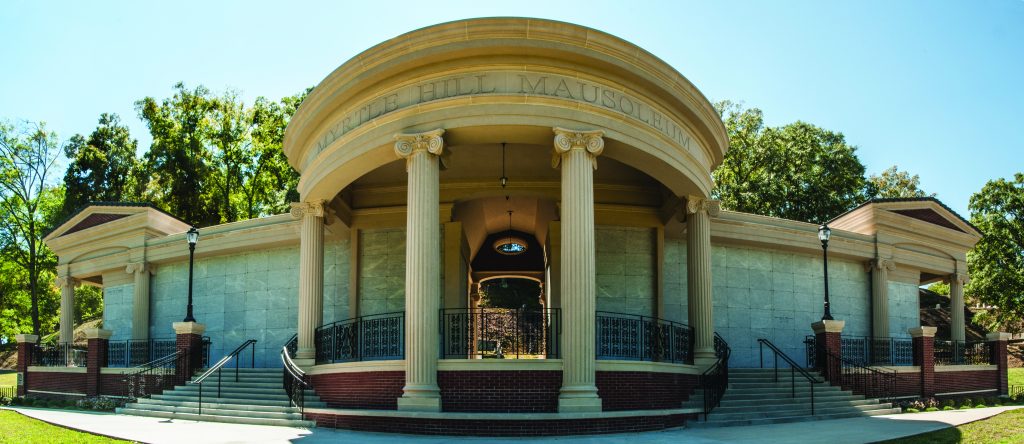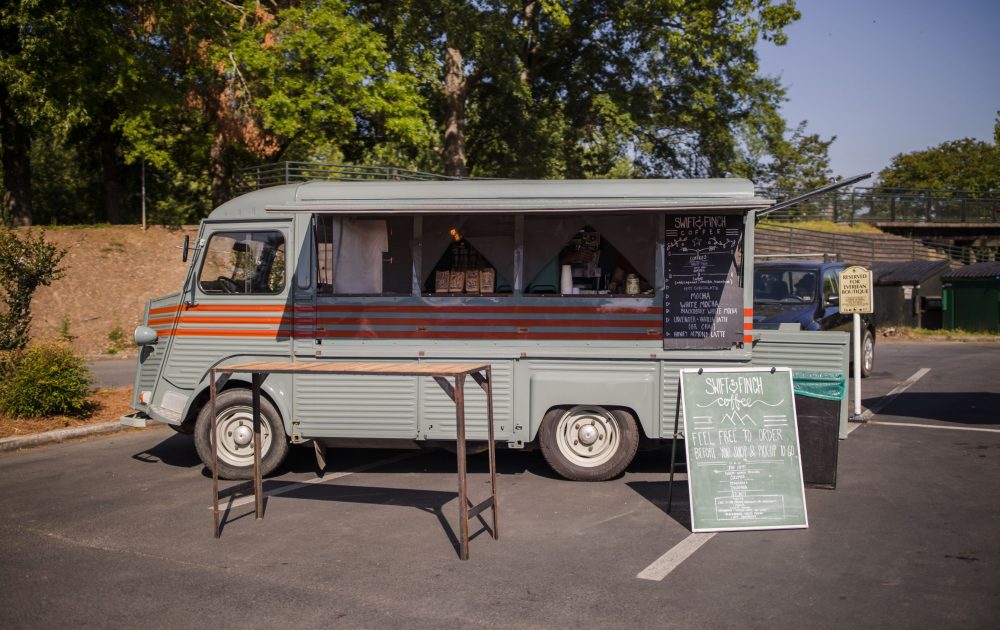
Photos by Derek Bell
Rising majestically from the confluence of the Etowah and Oostanaula rivers, Rome’s own Myrtle Hill Cemetery has stood sentinel over Rome since 1857. A member of the National Register of Historic Places, Myrtle Hill provides an amazing view of the local community and a stroll through its hallowed grounds reveals a snapshot of our community over time.
Some of those buried at Myrtle Hill are familiar and famous names, but others are not so well known. For example, there is Tom McClintock, who was interned in 1915. At that time, the cemetery was segregated, and McClintock was laid to rest in the plots formerly reserved for the area’s African-American neighbors. Living in the immediate vicinity, he had spent the previous 42 years working at the cemetery as a grave digger. Although the records of the very first person buried at Myrtle Hill have been lost over time, Mrs. Benjamin F. Hawkins and John Billups were both interned in March of 1857 and any notes prior to that time are unavailable.
The name itself, Myrtle Hill, has a bit of interesting history behind it as well. Its name was adopted from the Vinca Minor, a plant which grew wild over the hill in the late 1800s. It’s more common name is Myrtle, or the Flower of Death. Many Romans will recognize it as a light blue flowering vine/bush, as it is indigenous to the area now.
Among the over 20,000 graves at Myrtle Hill, are a number of famous ones that draw visitors both near and far. The most famous would likely be former first lady Ellen Louise (Axson) Wilson. Wife of then-President Woodrow Wilson, Ellen Wilson died in August of 1914. A native of Floyd County, she graduated from the Cherokee Baptist Female College, presently recognized as, Shorter University. She was brought home by the President and laid to rest in her hometown in the Axson family plot, where she still rests. On Aug. 11, Mrs. Wilson’s birthday, a rose laying ceremony was conducted graveside on Myrtle Hill. (Mrs. Wilson was the establisher of the now-famous White House Rose Garden in Washington, D.C.)
In 1923, another noteworthy addition was made to the cemetery with the “Known Soldier.” Charles W. Graves was one of the last American casualties of the First World War. He was originally selected to be buried at Arlington National Cemetery, but the honor was declined by his family and his remains were brought home to be interred on Armistice Day, more commonly referred to now as Veterans Day. Referred to locally as the Known Soldier, his official moniker is lengthy and is a true honor: “The designated representative of America’s Known Dead of the Great War 1917-1918 per President Warren D. Harding and the Congressional Record.”
Visitors can also view the granite monument honoring Gen. John Sevier, which was erected in 1901 by the Daughters of American Revolution. Sevier fought and defeated a force comprised of Cherokee and Creek Indians on Myrtle Hill on Oct. 17, 1793.
The War of Northern Aggression is represented, with over 300 Confederate soldiers from all 11 states buried there. Additionally, two northern soldiers are buried in the Civil War area.
Myrtle Hill was prominent in one of the Civil War’s more unusual stories. In May of 1863, Union Gen. Abel Streight was marching on Rome to destroy the manufacturing capability and disrupt Southern infrastructure. A fort, known as Fort Stovall, had been constructed to protect the city and its important industries, especially the Noble Foundry. The outnumbered defenders of Fort Stovall held off the Yankees until Gen. Nathan Bedford Forrest could arrive.
Although outnumbered 1,500 to 425, Forrest’s fierce reputation scared the northern force into fleeing. Streight abandoned the attempt to take Rome and fled west to escape Forrest. He eventually surrendered just over the Georgia-Alabama border, where a statue commemorates the embarrassing submission. A monument, which originally stood at the corner of Second Ave. and Broad St., is now located in the Veterans Plaza, where it was moved in 1952.
With the cessation of hostilities after the War, Myrtle Hill became a popular spot for Rome’s upper-class citizens to be buried. Among some of the more noted interned there are Daniel R. Mitchell, one of the founders of Rome; Daniel S. Printup; educator J. M. M. Caldwell; Alfred Shorter; Dr. Robert M. Battey, a pioneer in women’s surgery; Rep. John H. Underwood; Homer V. M. Miller; Augustus Romaldo Wright; Andrew B. S. Moseley; and Rep. Seaborn Wright.
Adding a modern touch to a site as historic as Myrtle Hill can be a bit of a challenge, to say the least. However, Rome has done so with style. Visitors are encouraged to take a self-guided tour via their mobile devices. One has only to download the mobile app tour. Atop Myrtle Hill is a newly installed plaque that introduces the tour. Simply photograph the QR code using your cell phone and the app will walk you through the cemetery, detailing the history and explaining the many fascinating graves.
Rome Cemetery Director Stan Rogers, who is responsible for all four official Rome cemeteries, as well as the Hebrew Cemetery located in South Rome, has been instrumental in the recent beautification of Myrtle Hill and the restoration of older graves. His goal has been to make the area more pedestrian friendly, park-like so to speak, and welcoming to local residents and tourists as well.
“Cemeteries are for the living,” he says, noting that the renovation efforts were funded with private donations from local citizens.
Rogers, who has served as cemetery director since 2001, also spearheaded the effort to design and build the Myrtle Hill Mausoleum, a project that is finally complete after 10 years in the making. The mausoleum contains 588 casket spaces with an additional 596 cremation niches. The mausoleum was dedicated during a special ceremony on Dec. 13, 2013.
The impressive structure was built by Milm Construction out of Portland, Ore. After initially intending to import the stone for the all-granite structure from China, Rogers decided instead to use a more local connection. He settled on Silver Cloud Granite, a company based in Lithonia, Ga., who has supplied the granite for such famous buildings as the Burj Khalifa, which – at the time of its construction in Dubai – was the tallest building in the world.
Find out more about the inspiration of the design by visiting American Cemetery online at www.americancemetery.com. The Myrtle Hill Mausoleum graced the cover of this publication’s September issue, an achievement that all Romans can be proud of.
“It is wonderful; there is nothing like it in neither Georgia nor the Southeast,” says Rogers proudly.
Overlooking the river, the Myrtle Hill Mausoleum sits in a peaceful and easily accessible location. Those interested in more information should contact William S. Kerestes, who is in charge of mausoleum sales, at 706-506-1919. You can also contact the City of Rome at 706-236-4534 for information about available space in the mausoleum and, of course, more details are available on Facebook by entering www.facebook.com/MyrtleHillMausoleumRomeGA in the address bar of your internet device.
More than just a resting place for the departed, Myrtle Hill continues to be a monument to Rome itself. Its quiet dignity and sweeping views offer a wonderful day-trip allowing visitors to experience some of Rome’s history. It is a place that all of us can be proud of and enjoy, especially with the recent upgrades and features put in place by Rogers and the City of Rome.



